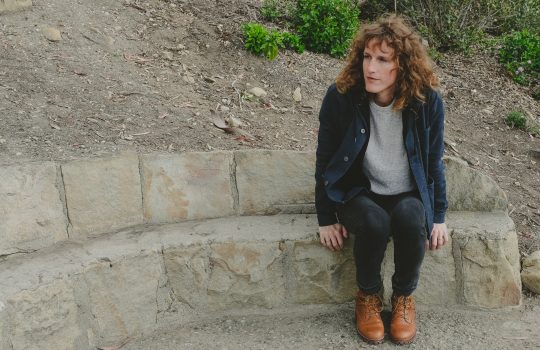The U.S Department of Energy’s Fermi National Accelerator Laboratory is pleased to announce that a New York-based duo, Chris Klapper and Patrick Gallagher, have been chosen as the lab’s 2020 artists-in-residence. Additionally, David Ibbett has been selected as the lab’s first guest composer for 2020.
Introducing 2020 artists-in-residence Chris Klapper and Patrick Gallagher

Multimedia artists Chris Klapper and Patrick Gallagher have been selected as Fermilab’s 2020 artists-in-residence. Photo: WallingMcGarity
Multimedia artists Klapper and Gallagher are keen to find new and innovative ways to connect art and science.
Klapper and Gallagher first started their collaboration in 2012 with their “Symphony in D Minor,” a massive self-contained thunderstorm, that allows visitors to reach up and push hand-casted sculptures hanging in the air, triggering the sound elements of the storm themselves.
“You think about physicists, and someone might have an idea, but it’s when they get other groups of people excited and involved that these incredible experiments happen,” Klapper said. “Just talking to people, forming those bridges and connections, is a huge part of what makes our art possible.”
Since that first collaborative installation, Klapper and Gallagher have explored the reaches of art, science and experience.
“I know people, me included, can be really intimidated by what we do here,” said Georgia Schwender, Fermilab Art Gallery curator. “But artists like Chris Klapper and Patrick Gallagher help bridge that gap and make it accessible. I’m so excited to see what they’ll be able to do and learn while here.”
Already, Klapper and Gallagher have a connection between their art and Fermilab. Throughout the month of December 2018, they created “Dataatadata: Everything and Nothing,” an immersive sound installation during which they built a sand mandala.
Originating in both Hinduism and Buddhism, mandalas were traditionally constructed as ritual symbols for the universe. Today, Buddhist monks lay single pieces of sand one at a time to construct sand mandalas that they then wipe away as a way to meditate on the impermanence of life.
For “Everything and Nothing,” Klapper and Gallagher followed a similar technique, painstakingly recreating an image of a particle collision in a bubble chamber, taken at Fermilab decades prior, one grain at a time before sweeping it all away at the end of their 30-day performance.
Klapper and Gallagher plan to visit Fermilab at least three times throughout the year, drawing first-hand inspiration from the scientists and projects going on at Fermilab. While eager to begin, the duo is waiting for their first visit before fully brainstorming their next science-inspired, immersive multimedia installation.

Inspired by Andean textiles, current Fermilab artist-in-residence Isaac Facio is developing a pattern that shows neutrino oscillations within a detector, representing the moment a neutrino changes from one flavor to another. Image: Isaac Facio
“We both follow science news, and Fermilab is always on the leading edge,” Gallagher said. “There’s just this incredible stuff being done there that not everyone can easily grasp, and it’s really just an incredible opportunity we’ve been given to be a kind of translator for that.”
Fermilab’s artist-in-residence program began in 2014, connecting the laboratory’s science with audiences through art. Artist Lindsay Olson kicked off the program. Since then the lab has continued to host incredible artists: multimedia artists Ellen Sandor in 2016, sculptor Jim Jenkins in 2017, photographer Adam Nadel in 2018 and textile specialist Isaac Facio in 2019.
“People were very generous with their time,” Facio said. “This has been an amazing opportunity, to be able to connect my enthusiasm for textiles with the passion that everyone at Fermilab has for science has been so inspiring.”
Facio is working with digital loom technology to depict the subatomic world through cloth and three-dimensional woven textiles. He will display his work in the Fermilab Art Gallery in November 2020.
Introducing 2020 guest composer David Ibbett

Composer David Ibbett has been selected as Fermilab’s first guest composer. Photo: Nile Scott Photography
Like Klapper and Gallagher, Ibbett explores the intersection of art and science in novel ways.
Ibbett, a Boston-based composer and musician, grew up learning piano from his mother and reading stories of the latest scientific breakthroughs in the New Scientist magazines that his research chemist father always had in the house. For Ibbett, these passions remained separate until his doctoral recital, where he composed a tone poem inspired by the search for life on Europa, one of Jupiter’s 67 known moons.
Since this first endeavor, Ibbett has only dived further into linking music with science, working with science consultants to ensure he’s representing the research and data correctly.
“It turns out scientists are really passionate about music,” Ibbett said. “So, there’s a huge potential for cross pollination and the creation of musical metaphors for scientific concepts – such as mapping parameters like pitch and rhythm to reveal the depth and complexity of a given topic.”
His current project is related to the search for planets outside our solar system, known as exoplanets. One of the ways scientists find these exoplanets and determine whether they could sustain life is through spectroscopy.
When a planet passes in front of its host star, the light we receive from that star alters slightly. Scientists can read these alterations, which can be thought of as gaps in very specific sections of the wavelengths of the star’s light, and determine precisely what that planet’s atmosphere consists of.
With the help of astrophysicist Roy Gould of Harvard-Smithsonian Center for Astrophysics, Ibbett’s work maps these missing wavelengths to musical notes to create an album of the different molecules that may allow these exoplanets to be able to sustain life.
“I’m writing a piece on methane at the moment,” he said. “To make something like this work, with a piano for instance, you have to do some note rounding, but you want to ensure that your rounding doesn’t destroy or alter the data too much.”
In order to transform the data given to him into musical notes, Ibbett has to take a few creative liberties, which he refers to as note rounding. Since not every data point perfectly lines up with an existing note on the piano, Ibbett determines the next best key to use, being careful to maintain as much consistency as possible between data and musical pitches.
“We’ve had discussions before about expanding the artists-in-residence program beyond just visual artists,” said Janet Mackay-Galbraith, the head of the Fermilab Arts and Lecture Series. “When David’s application came in, I didn’t want to let it go by, because his love and skill in combining music and science was such an exciting new venture for the lab to explore.”
Ibbett will be the lab’s first guest composer. He plans to visit the lab at least three times over the course of the year, and there is talk of showcasing his work as part of Fermilab’s Gallery Chamber Series in 2021.



